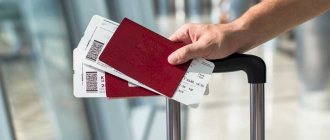Free luggage size on the bus
Ecolines buses allow you to carry up to three pieces of luggage free of charge, the weight of each piece should not exceed 30 kg.
The volume is divided as follows:
- for 1 (one) piece of luggage - dimensions should not exceed 80x50x50 cm;
- for 2 (two) pieces of luggage - the dimensions of each piece should not exceed 50x50x40 cm;
- for 3 (three) pieces of luggage - the dimensions of each piece should not exceed 60x55x20 cm.
In addition, child passengers are allowed to transport a folded stroller free of charge (if there is no other luggage). Disabled passengers can check in a wheelchair free of charge (only folded).
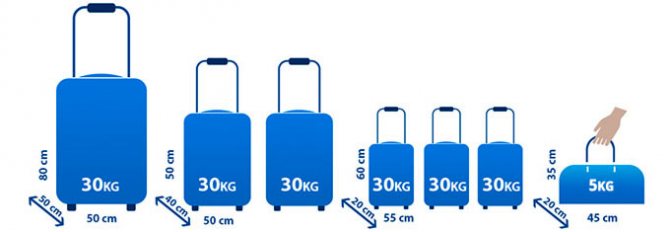
Driver's rights and responsibilities
Clause 1 of Part 1 of Article 34.1. Federal Law No. 220 requires that only a driver who has an employment relationship with the carrier as a legal entity or individual entrepreneur be allowed to drive a bus.
In this case, information about such a driver must be contained in the register of passenger transportation routes. During the period of preparation for the route and departure for the flight, the driver must comply with the duties that are regulated by the instructions of the specific carrier.
Please note! They are as follows:
- undergo a pre-trip medical examination;
- check the external and internal condition of the bus;
- is the bus fueled, what condition are the tires in;
- presence and serviceability of rear view mirrors;
- operability of emergency exits;
- while driving, adhere to the established schedule of arrival at destinations;
- have identification documents with you, as well as a driver’s license, which must be presented at the request of the traffic police;
- while driving, wear a uniform for the driver, if it is provided by the carrier;
- When the bus stops for more than 5 minutes, turn off the engine;
- choose driving speed depending on the condition of the roadway and weather conditions in order to ensure traffic safety;
- carry other responsibilities.
What baggage do you need to pay for on the bus?
If there is free space in the luggage compartment of the bus and for a fee, Ecolines can accept additional luggage from the passenger. The free space in the luggage compartment is determined by the driver upon boarding, taking into account the total number of passengers on the bus, distribution by city and other factors.
According to the rules, you can carry no more than two pieces of additional baggage per passenger. In the case of one piece of additional luggage, its dimensions should not exceed 50x50x80 cm; for two pieces of luggage, the dimensions of each piece should not exceed 40x50x50 cm.
For each piece of additional baggage, the passenger is charged 20 EUR (up to 30 kg). For each piece of luggage exceeding 30 kg, you will be charged 20 EUR. You can pay in another currency - you will be paid at the bank rate.
When checking in luggage, the passenger must keep in mind that throughout the flight, access to personal belongings in the luggage compartment is closed.
When paying for additional baggage, the passenger is given a payment receipt, on the basis of which the passenger can receive a strictly accountable receipt and a cash receipt at Ecolines representative offices. It is prohibited to carry additional baggage without a payment receipt.
A sticker with a number is affixed to each piece of transported baggage, and a corresponding sticker with the same number is affixed to the passenger’s ticket. Baggage is issued only upon presentation by the passenger of the appropriate luggage sticker.
The carrier has the right to ask the passenger to present the contents of their luggage. This is done solely for security purposes. In case of refusal, the carrier has the right not to allow the passenger to travel. This complies with the Rules for the carriage of passengers and baggage by road and urban ground electric transport.
What you don't have to pay for
In the cabin of a bus on urban and suburban routes, passengers do not have to pay for hand luggage if it is no more than 120 cm (length, width and height in total); they can also safely board the bus with a stroller or sled. It is important to remember here that the carrier has the right to set its own standards for the size of hand luggage for free transportation. You don’t have to pay for transporting one pair of skis, but it’s better to cover them first. Transported items must be clean, not block the passage in the bus and not interfere with other passengers getting on and off at stops. If these conditions are not met, the driver has the right to refuse to carry hand luggage.
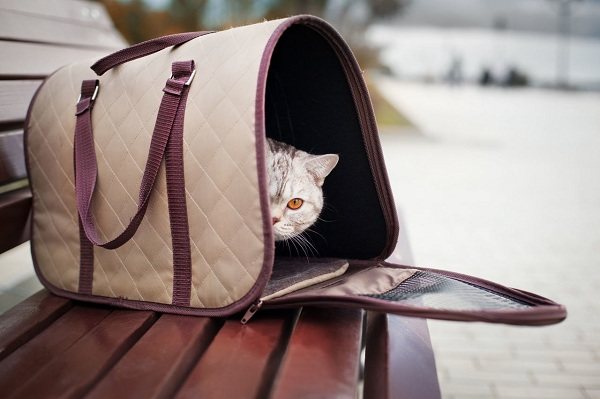
Such “hand luggage” is regulated by the rules for transporting animals on buses
Transporting special luggage on Ecolines
Sport equipment
Only a limited number of sets of sports equipment are accepted on each flight. Therefore, passengers planning to carry sports equipment with them must inform the carrier in advance.
Bike
Bicycles (folded and packed) are accepted with written permission for transportation on the lines Riga - Tallinn, Riga - Tartu, Riga - Vilnius, Riga - Kaliningrad, Riga - Minsk, Riga - Marijampole, Liepaja - Marijampole, Kaliningrad - Warsaw, Kaliningrad - Gdynia , Tallinn - St. Petersburg.
The cost of the service is 30 EUR (or equivalent in another currency). It is better to pay in advance at the Ecolines representative office.
On other routes, bicycles are accepted for carriage only with the written permission of the carrier at an agreed price.
Musical instruments
Musical instruments exceeding the size of hand luggage are accepted for carriage only with the written permission of the carrier. If the size of a musical instrument allows it to be placed in the bus (guitar, cello, etc.), then the passenger must pay for a second seat next to him. If a passenger decides to check in a musical instrument in the luggage compartment (payment of 20 EUR), then the passenger takes responsibility for the safety and working condition of the instrument.
Is it possible to take a scooter on the bus?
According to Ecolines rules, scooters, both adults and children, are accepted for transportation only with the written permission of the carrier and for an additional fee.
Permission can be obtained via email. If you have the carrier AMRON on your flight, then write to the post office, if the carrier is Ecolines Estonia, then write to the post office
If the dimensions of the packaged scooter do not exceed 50x50x80 cm and the weight is 30 kg, then the cost of transporting the scooter is 20 euros.
If at least one of the linear dimensions exceeds the established size (50x50x80 cm) or weight (over 30 kg), then the cost of transporting the scooter on the bus is 30 euros.
How much does extra luggage cost?
We have already indicated above what size luggage you can take with you for free. If your suitcase is larger or you want to take several bags with you, you will have to pay for them at the rates set by the carrier. Unfortunately, they are not regulated; each bus company sets them.
On average, the cost of additional luggage is 10-15% of the ticket price. You can pay for your luggage either directly on the bus (the driver will accept the money) or at the ticket office at the bus station.
For example, in the Moscow region, carrying luggage whose parameters exceed the established norm will cost 22 rubles if you are traveling 25 kilometers or less from the city, 44 rubles (distance from 25 to 50 kilometers) or 66 rubles (over 60 kilometers from Moscow ).
If you travel by bus to Europe, fares will be in euros. The average surcharge will be from 10 to 15 euros per bag. Transporting a folded bicycle will cost 10-20 euros, depending on the carrier.
Please note that they can accept a child’s sled, a pair of skis, small animals and birds in a cage for free - but this will be hand luggage, and you will have to fit them in the cabin.
In addition, strollers and wheelchairs will be accepted free of charge and without questions asked. Both will need to be added.
Please also note that oversized cargo may not be accepted even with an additional payment if there is not enough space in the luggage compartment. It is better to clarify this issue in advance at the bus station or directly with the carrier.
Hand luggage on an Ecolines bus
In accordance with Ecolines rules, hand luggage is small personal items not exceeding dimensions 45x35x20 cm and weight 5 kg (outerwear, handbag, bottle of water, umbrella, laptop, etc.).
Hand luggage is carried free of charge. It should be located under the passenger’s feet or on the luggage rack in the cabin. It is prohibited to place hand luggage in the aisle of the bus.
According to the Rules for the carriage of passengers and baggage by road and urban ground electric transport, approved by the Government of the Russian Federation, the passenger is responsible for the integrity and safety of hand luggage; this is his responsibility.
How to transport an animal on a bus

Photo: @freestocks
It all depends on what kind of animal you take with you. According to the rules for transporting luggage on buses, small animals (dogs, cats, rabbits) travel with the owner for free: they are considered hand luggage. For a large dog you will have to buy a ticket, as well as a muzzle and a leash.
A small dog or cat will have to be placed in a special container, bag or carrier basket. It is best to carry it in your arms: it can shake on the floor, the sound of the engine can be heard better and the legs of passing passengers flash, which is not very good for the animal’s condition (transportation itself is stressful, do not aggravate it).
If you are traveling with a large dog, you will be seated in the back of the bus. You cannot let the animal off the leash while driving, and at stops, if you go out to get some fresh air and stretch your legs, you will have to take it with you.
Be prepared to present a certificate from a veterinarian about the health status of your pet (Veterinary Certificate, Form No. 1). The certificate must contain information about vaccinations, including against rabies (it is valid for 1 year).
Prohibited for transportation on buses
The carrier does not accept large-sized cargo for transportation in the luggage compartment: building materials, car parts, furniture, household and electrical equipment, including any refrigerators, washing machines and dishwashers, electric and gas stoves, TVs, video and music systems, etc.
The carrier has the right to refuse to transport baggage if: the content, structure, shape or smell of the baggage or cargo may damage or stain the baggage of other passengers, the interior of the bus or the luggage compartment, or may disturb the passengers or crew of the bus.
Car company liability for luggage
According to the rules established by Ecolines, when transporting luggage on a bus in the luggage compartment, the car company is only responsible for the presence of a piece of luggage, but does not guarantee its integrity or functionality. The carrier does not accept responsibility for minor or superficial damage to your suitcase. In particular, for broken wheels and handles, lost harness straps and minor damage such as cuts, scratches, creases or stains that occur during normal wear and tear and use during travel.
How much luggage can you carry on Lux Express buses - read here.
Photo: vk.com/ecolinesnet
DoedemKlassno
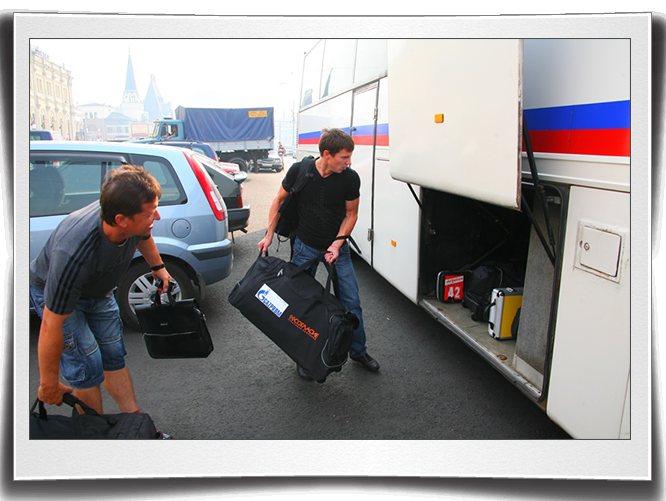
Hand luggage
According to the rules of most carriers, a passenger is entitled to one free piece of carry-on luggage, including a baby stroller. Carry-on luggage is considered to be items that a passenger carries with him in a vehicle and the safety of which during transportation is ensured by the passenger. It is allowed to carry items as hand luggage, regardless of their type and packaging, if their size does not restrict the passage of other passengers.
Attention! It is the passenger’s responsibility to take care of the integrity and safety of hand luggage transported inside the bus. Claims related to damage or loss of passengers' carry-on luggage will not be accepted by the carrier.
Baggage
Baggage is considered to be the belongings of passengers transported separately from the passenger on the same flight in the luggage compartment of the bus. The price of the bus ticket includes luggage with dimensions no more than 20 cm * 40 cm * 60 cm or 120 cm in the sum of three dimensions and weighing no more than 20 kg. Larger luggage requires a separate ticket.
Additional baggage ticket
An additional ticket provides for the carriage of baggage with dimensions of no more than 100 cm * 50 cm * 30 cm or 180 cm in the sum of three dimensions and weighing no more than 60 kg. Baggage exceeding these parameters is considered oversized. A ticket for additional luggage must be purchased along with the passenger ticket. The cost of the ticket is determined by the carrier.
Oversized luggage
Please check with the carrier for rules regarding the carriage of oversized baggage by calling the phone number indicated on the ticket.
!Prohibited items!
Attention! The following items are prohibited for transportation on the bus: flammable, explosive, poisonous, flammable, toxic, caustic and foul-smelling substances, firearms without cases or unpacked, objects and things that pollute or can damage the rolling stock or the clothing of passengers. Passenger's belongings that have not passed customs clearance, as well as all other items, goods, substances prohibited for transportation across the state border of the Russian Federation, are not allowed for international transportation.
Attention! These rules are not binding; carriers may act in accordance with their own tariffs. You can get advice by calling the phone number listed on the website.
- Passengers are prohibited from transporting the following items and substances in the form of hand luggage and baggage: 1) explosives, explosives and objects filled with them: all kinds of gunpowder, in any packaging and in any quantity; live ammunition (including small-caliber); gas cartridges weapons; hunting caps (pistons); pyrotechnics: signal and lighting flares, signal cartridges, landing bombs, smoke cartridges (checkers), demolition matches, sparklers, railway firecrackers; TNT, dynamite, tal, ammonal and other explosives; capsules -detonators, electric detonators, electric igniters, detonating and fire cord;
- compressed and liquefied gases: gases for household use (butane-propane) and other gases; gas cartridges filled with nerve-paralytic and tear effects;
- flammable liquids: acetone; gasoline; samples of flammable petroleum products; methanol; methyl acetate (methyl ether); carbon disulfide; ethers; ethylcellosol;
- flammable solids: substances subject to spontaneous combustion; substances that emit flammable gases when interacting with water: potassium, sodium, metallic calcium and their alloys, calcium phosphorous; white, yellow and red phosphorus and all other substances classified as flammable solids ;
- oxidizing substances and organic peroxides: colloidal nitrocellulose, in granules or flakes, dry or wet, containing less than 25% water or solvent; colloidal nitrocellulose, in pieces, wet, containing less than 25% alcohol; dry or wet nitrocellulose, containing less than 30% solvent or 20% water;
- toxic substances;
- radioactive materials;
- caustic and corrosive substances: strong inorganic acids: hydrochloric, sulfuric, nitric; hydrofluoric acid and other strong acids and corrosive substances;
- toxic and toxic substances: any poisonous, potent and toxic substances in liquid or solid state, packaged in any container; brucine; nicotine; strychnine; tetrahydrofurfuryl alcohol; antifreeze; brake fluid; ethylene glycol; mercury; all salts of hydrocyanic acid and cyanide preparations; cyclone, cyanogen alloy, arsenous anhydride; other things (objects) that can damage or pollute the passenger compartments and cabins of the ship, harm the life and health of passengers, and also be used as a weapon of attack against passengers and crew of the ship;
- pistols, revolvers, rifles, carbines and other firearms, gas, pneumatic weapons, electroshock devices, daggers, stilettos, airborne bayonets, except in cases and in the manner established by the legislation of the Russian Federation.
Rules for the carriage of baggage.
Terms used in the rules
1.1. Baggage – passenger’s belongings intended for transportation in the luggage compartment of the bus.
1.2. Hand luggage - small personal items not exceeding dimensions 45 cm x 35 cm x 20 cm and weight 5 kg (outerwear, handbag, bottle of water, umbrella, laptop, etc.).
General rules
2.1. When transporting luggage in the luggage compartment of a bus, the carrier is responsible only for the presence of a piece of luggage, but does not guarantee the preservation of its integrity or functionality. The Carrier does not accept responsibility for minor or superficial damage to baggage, in particular for broken wheels and handles, lost seat belts and minor damage such as cuts, scratches, creases or stains that occur during normal wear and tear and use during travel. The passenger is responsible for the safety of hand luggage.
2.2. When checking in luggage, the passenger must keep in mind that throughout the flight, access to personal belongings in the luggage compartment is closed.
2.3. Baggage is issued only upon presentation by the passenger of the appropriate luggage sticker.
2.4. The Passenger himself is responsible for the safety of hand luggage during the flight, including during stops and borders.
2.5. For security reasons, the Carrier has the right to ask to see the contents of the baggage. In case of refusal, the Carrier has the right not to allow the passenger to travel.
Free baggage transportation
3.1. You are allowed to transport free of charge:
3.1.1. Hand luggage, which must be kept in the passenger compartment of the bus. Carry-on luggage is located under your feet or on the luggage rack. It is prohibited to place hand luggage in the aisle of the bus.
3.1.2. Up to 3 (three) pieces of luggage, the total volume of which does not exceed 0.2 m3 and the weight of each piece does not exceed 30 kg. The volume is divided as follows: 3.1.2.1. For 1 piece of luggage: linear dimensions should not exceed 50*50*80 cm.
3.1.2.2. For 2 pieces of luggage: the linear dimensions of each piece should not exceed 40*50*50 cm.
3.1.2.3. For 3 pieces of luggage: the linear dimensions of each piece should not exceed 20*55*60 cm.
3.1.3. Passengers - children: a baby stroller (only folded), in the absence of other luggage.
3.1.4. For passengers with disabilities: a wheelchair (only folded).
Right to refuse transportation
4.1. The carrier does not accept large-sized cargo for transportation in the luggage compartment: building materials, car parts, furniture, household and electrical equipment, including any refrigerators, washing machines and dishwashers, electric and gas stoves, TVs, video and music systems, etc. 4.2. The carrier has the right to refuse to transport baggage if:
4.2.1. The contents, structure, shape or odor of luggage or cargo may damage or stain the luggage of other passengers, the interior of the bus or luggage compartment, or may disturb passengers or crew of the bus.
4.2.2 The bus crew suspects that the contents of the bags may cause delays during border crossing.
*You can only take water and fruit with you on board the bus. The remaining food products are checked into a special luggage compartment;
*The Company is not responsible for things left on the bus!!! *All applications regarding lost luggage are accepted for consideration no later than 48 hours from the moment the passenger arrives at the destination indicated on the ticket.
The cost of luggage varies from carrier to carrier.
Bus requirements
The requirements for the bus are as follows:
- it must be owned or otherwise legally owned by the carrier (Part 2 of Article 34.1 of Federal Law No. 220);
- There must be a route indicator on the windshield, on the rear window and on the right side of the bus body (clause 29 of the Rules);
- the sign on the windshield must contain the names of the starting and ending points;
- the sign on the right side of the body must contain not only the names of the starting and ending points, but also the names of the main intermediate stopping points;
- the height of the indicator placed on the windshield should be no more than 14 cm (clause 31 of the Rules);
- also on the windshield or on the right side of the body there must be information about the carrier (clause 36 of the Rules) - its short or full name.
The information provided for in clause 37 of the Rules must be placed inside the bus, namely:
- name, address, telephone number of the carrier;
- Full name of the driver and conductor;
- name, address and telephone number of the regulatory authority;
- seat numbers (except for buses, tickets for which do not provide specific seat numbers);
- price of travel and baggage;
- signs for places for people with children and people with disabilities;
- indicators of the location of fire extinguishers, emergency vehicle stop buttons, emergency exits;
- rules for using a vehicle or an extract from them.
The bus must also meet all safety requirements established in 196-FZ of December 10, 1995 “On Safety...” and undergo technical inspection every six months (clause “b”, clause 1, part 1, article 15 of Federal Law No. 170 of July 1, 2011 year “About technical…”).
Rules for transporting passengers in a car
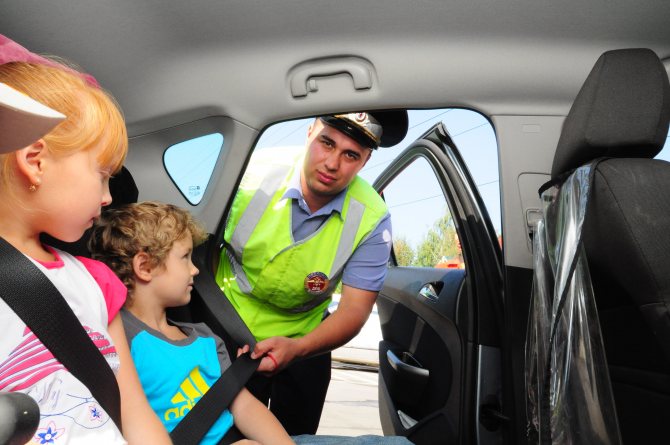
In the 2020 Traffic Regulations, the rules for the transportation of passengers are separated into a separate section, called “Transportation of People.”
I want to say right away that this article will not consider paragraphs 22.1-22.6 of the traffic rules related to the transportation of passengers in the back of a truck. This will be discussed in a separate article, but today we will only consider the rules for transporting passengers in a car or bus.
Boarding and disembarking passengers
Let's consider clause 22.7 of the traffic rules:
22.7. The driver is obliged to board and disembark passengers only after the vehicle has come to a complete stop, and to start driving only with the doors closed and not open them until the vehicle has come to a complete stop.
Please note that passengers can only board and disembark after the vehicle has come to a complete stop. I have repeatedly observed a situation where the driver of a car starts moving even before the passenger door is closed.
Naturally, in this case, not only the rules for transporting passengers are violated, because In addition, passengers do not have time to fasten their seat belts. Fines for incorrectly transporting passengers will be discussed later in this article.
Exceeding the permitted number of passengers
Clause 22.8 of the traffic rules:
22.8. It is prohibited to transport people:
- outside the cabin of a car (except for cases of transportation of people in the back of a truck with a flatbed or in a van), tractor, other self-propelled vehicles, on a cargo trailer, in a caravan trailer, in the back of a cargo motorcycle and outside the seating areas provided for by the design of the motorcycle;
- in excess of the amount provided for by the technical characteristics of the vehicle.
Let's look at this point in more detail:
- It is prohibited to transport people outside the cabin of a passenger car . This point is violated by drivers, although not often, but quite regularly. Extreme enthusiasts try to transport passengers in the trunk, on the roof of the car and on the hood. Naturally, in the event of the death of such passengers in an accident, all the blame will fall only on the negligent driver.
- It is prohibited to carry extra passengers . For passenger cars, the number of passengers is limited by the number of seats, for buses - the number provided for by its technical characteristics.









